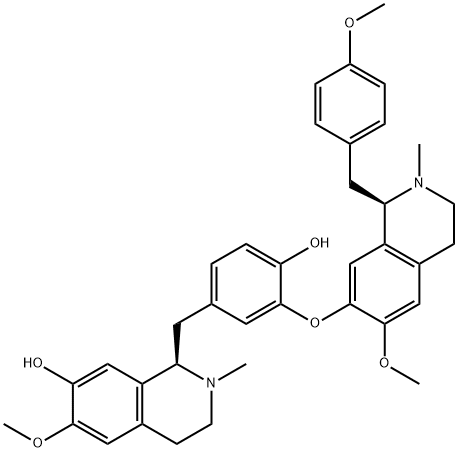Physicochemical Properties
| Molecular Formula | C37H42N2O6 |
| Molecular Weight | 610.7392 |
| Exact Mass | 610.304 |
| CAS # | 6817-41-0 |
| Related CAS # | 6817-41-0 |
| PubChem CID | 5274591 |
| Appearance | White to off-white solid |
| Density | 1.2±0.1 g/cm3 |
| Boiling Point | 723.1±60.0 °C at 760 mmHg |
| Melting Point | 69-71℃ |
| Flash Point | 391.1±32.9 °C |
| Vapour Pressure | 0.0±2.4 mmHg at 25°C |
| Index of Refraction | 1.618 |
| LogP | 4.72 |
| Hydrogen Bond Donor Count | 2 |
| Hydrogen Bond Acceptor Count | 8 |
| Rotatable Bond Count | 9 |
| Heavy Atom Count | 45 |
| Complexity | 917 |
| Defined Atom Stereocenter Count | 2 |
| SMILES | O(C1=C(C([H])=C([H])C(=C1[H])C([H])([H])[C@]1([H])C2=C([H])C(=C(C([H])=C2C([H])([H])C([H])([H])N1C([H])([H])[H])OC([H])([H])[H])O[H])O[H])C1=C(C([H])=C2C([H])([H])C([H])([H])N(C([H])([H])[H])[C@]([H])(C([H])([H])C3C([H])=C([H])C(=C([H])C=3[H])OC([H])([H])[H])C2=C1[H])OC([H])([H])[H] |
| InChi Key | AJPXZTKPPINUKN-FIRIVFDPSA-N |
| InChi Code | InChI=1S/C37H42N2O6/c1-38-15-13-26-20-36(44-5)37(22-29(26)30(38)16-23-6-9-27(42-3)10-7-23)45-35-18-24(8-11-32(35)40)17-31-28-21-33(41)34(43-4)19-25(28)12-14-39(31)2/h6-11,18-22,30-31,40-41H,12-17H2,1-5H3/t30-,31-/m1/s1 |
| Chemical Name | (1R)-1-[[4-hydroxy-3-[[(1R)-6-methoxy-1-[(4-methoxyphenyl)methyl]-2-methyl-3,4-dihydro-1H-isoquinolin-7-yl]oxy]phenyl]methyl]-6-methoxy-2-methyl-3,4-dihydro-1H-isoquinolin-7-ol |
| Synonyms | Isoliensinine |
| HS Tariff Code | 2934.99.9001 |
| Storage |
Powder-20°C 3 years 4°C 2 years In solvent -80°C 6 months -20°C 1 month Note: This product requires protection from light (avoid light exposure) during transportation and storage. |
| Shipping Condition | Room temperature (This product is stable at ambient temperature for a few days during ordinary shipping and time spent in Customs) |
Biological Activity
| Targets |
Isoliensinine induces apoptosis in triple-negative human breast cancer cells through ROS generation and p38 MAPK/JNK activation[1]. On CASMCs induced by phenylephrine, isoliensinine has an antiproliferative effect. Its mechanisms involve reducing the overexpression of growth factors (PDGF-beta, bFGF), protooncogenes (c-fos, c-myc), and hsp70[3]. |
| ln Vitro | Isoliensinine promotes apoptosis in triple-negative human breast cancer cells through ROS production and p38 MAPK/JNK activation [1]. Isorisinine has an anti-proliferative effect on phenylephrine-induced CASMCs, and its mechanism is connected to lowering the overexpression of growth factors (PDGF-β, bFGF), proto-oncogenes (c-fos, c-myc) and hsp70[3]. |
| References |
[1]. Effects of isoliensinine on proliferation of porcine coronary arterial smooth muscle cells induced by phenylephrine. Yao Xue Xue Bao. 2005 Feb;40(2):105-10. [2]. Isoliensinine induces apoptosis in triple-negative human breast cancer cells through ROS generation and p38 MAPK/JNK activation. Sci Rep. 2015 Jul 29;5:12579. [3]. Effects of isoliensinine on proliferation of porcine coronary arterial smooth muscle cells induced by phenylephrine. Yao Xue Xue Bao. 2005 Feb;40(2):105-10. |
| Additional Infomation |
Isoliensinine is a member of isoquinolines. Isoliensinine has been reported in Nelumbo nucifera with data available. |
Solubility Data
| Solubility (In Vitro) |
DMSO: 50~100 mg/mL(81.9~163.7 mM) Ethanol: ~100 mg/mL(~163.7 mM) |
| Solubility (In Vivo) |
Solubility in Formulation 1: ≥ 2.5 mg/mL (4.09 mM) (saturation unknown) in 10% DMSO + 40% PEG300 + 5% Tween80 + 45% Saline (add these co-solvents sequentially from left to right, and one by one), clear solution. For example, if 1 mL of working solution is to be prepared, you can add 100 μL of 25.0 mg/mL clear DMSO stock solution to 400 μL PEG300 and mix evenly; then add 50 μL Tween-80 to the above solution and mix evenly; then add 450 μL normal saline to adjust the volume to 1 mL. Preparation of saline: Dissolve 0.9 g of sodium chloride in 100 mL ddH₂ O to obtain a clear solution. Solubility in Formulation 2: ≥ 2.5 mg/mL (4.09 mM) (saturation unknown) in 10% DMSO + 90% (20% SBE-β-CD in Saline) (add these co-solvents sequentially from left to right, and one by one), clear solution. For example, if 1 mL of working solution is to be prepared, you can add 100 μL of 25.0 mg/mL clear DMSO stock solution to 900 μL of 20% SBE-β-CD physiological saline solution and mix evenly. Preparation of 20% SBE-β-CD in Saline (4°C,1 week): Dissolve 2 g SBE-β-CD in 10 mL saline to obtain a clear solution. Solubility in Formulation 3: ≥ 2.5 mg/mL (4.09 mM) (saturation unknown) in 10% DMSO + 90% Corn Oil (add these co-solvents sequentially from left to right, and one by one), clear solution. For example, if 1 mL of working solution is to be prepared, you can add 100 μL of 25.0 mg/mL clear DMSO stock solution to 900 μL of corn oil and mix evenly. (Please use freshly prepared in vivo formulations for optimal results.) |
| Preparing Stock Solutions | 1 mg | 5 mg | 10 mg | |
| 1 mM | 1.6374 mL | 8.1868 mL | 16.3736 mL | |
| 5 mM | 0.3275 mL | 1.6374 mL | 3.2747 mL | |
| 10 mM | 0.1637 mL | 0.8187 mL | 1.6374 mL |
